Energy Transformation Civil Disobedience for the Climate
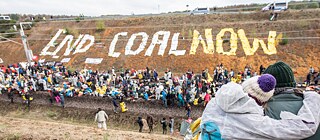
Germany has decided to phase out coal, but energy company RWE is still clearing forests and relocating villages in the coal mining areas in the Rhineland. There has been resistance and protest from many corners, including “Ende Gelände” and “Triole gegen Kohle”.
A strong wind is blowing across the Garzweiler ligate mine near Mönchengladbach on this day. Down in the open pit, excavators continue to dig the brown gold out of the earth. But more than coal mining is happening here. There are also roughly a hundred wind turbines dotted around the small town of Lützerath, right next to the thousands of hectares of coal mine. Though half of them are currently not moving.
Not because they are out of order though: The turbines have been switched off because the grid is saturated. Energy production is shut down where there is enough of it – and because you cannot just flip a switch to turn off the aging coal-fired power plants next door, the wind turbines rest while the excavators keep shovelling. This is how the inertia of the coal industry is very directly preventing the generation and use of renewable energy here, day in, day out.
Extractors shoulder to shoulder with wind turbines – the conflict between coal and renewables is very tangible in Lützerath. The coal company and civil resistance groups are fighting a pitched battle here, as unspoiled nature does its best to survive next to the open pit mine. There are barely ten houses left in Lützerath, and only three people still live there officially. Nevertheless – or maybe precisely for this reason – this tiny hamlet perched on the edge of Europe’s largest coal mine has become the new symbol for the fight against the brown coal causing so much harm to the climate. The village has already been almost completely cleared to make way for more coal mining.
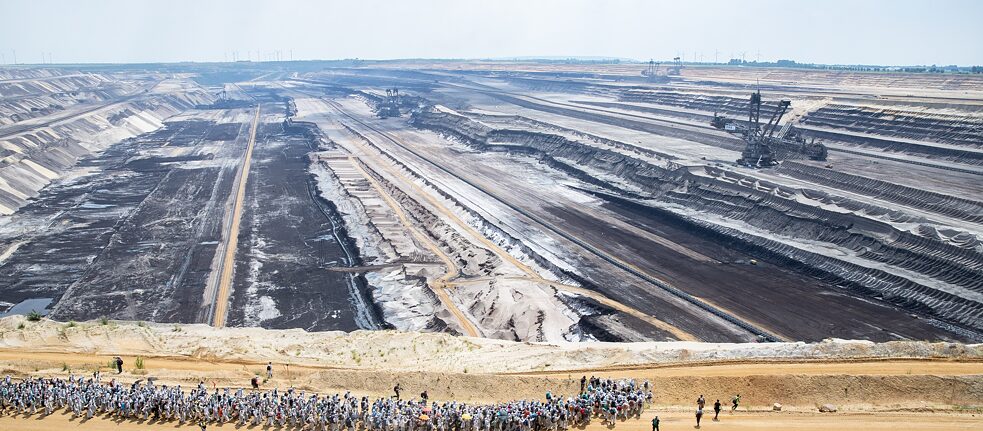 Anti-coal activists on the edge of the Garzweiler open pit mine in 2019. The white coveralls are a trademark of the Ende Gelände alliance.
| Photo (detail): © picture alliance/dpa/Marcel Kusch
Gesturing toward the excavator, Bastian Neuwirth of Greenpeace says, “Paris is at stake in Lützerath, the 1.5 degree limit.” He notes that if the pit here is enlarged and the coal underneath is burnt, Germany will have to renege on its promise from the Paris climate agreement. The nearly 900 million tons of lignite RWE still plans to mine, he argues, would exceed the maximum CO2 levels set out in the climate agreement many times over. That is why he is here today with other activists, residents and conservationists: They all want to block the mine’s expansion.
Anti-coal activists on the edge of the Garzweiler open pit mine in 2019. The white coveralls are a trademark of the Ende Gelände alliance.
| Photo (detail): © picture alliance/dpa/Marcel Kusch
Gesturing toward the excavator, Bastian Neuwirth of Greenpeace says, “Paris is at stake in Lützerath, the 1.5 degree limit.” He notes that if the pit here is enlarged and the coal underneath is burnt, Germany will have to renege on its promise from the Paris climate agreement. The nearly 900 million tons of lignite RWE still plans to mine, he argues, would exceed the maximum CO2 levels set out in the climate agreement many times over. That is why he is here today with other activists, residents and conservationists: They all want to block the mine’s expansion.
Living in Trees and Blocking Earth Movers
A broad alliance has been protesting brown coal for a long time now. Members of the “Ende Gelände” environmental alliance are most conspicuous in the white painter’s coveralls they wear when protesting and occupying the open pit mine. They call themselves the “Association of Disobedient Climate Justice Groups,” and have been officially targeted by the Germany’s Office for the Protection of the Constitution and are therefore classified as “left-wing extremist” by many media outlets.
On this particular day, Ende Gelände spokesperson Emilia Lange is on site. She says the group’s decentralised work in many cities, in local associations, and in small groups is responsible for their successes. The alliance uses civil disobedience to campaign primarily against the mining of fossil fuels.
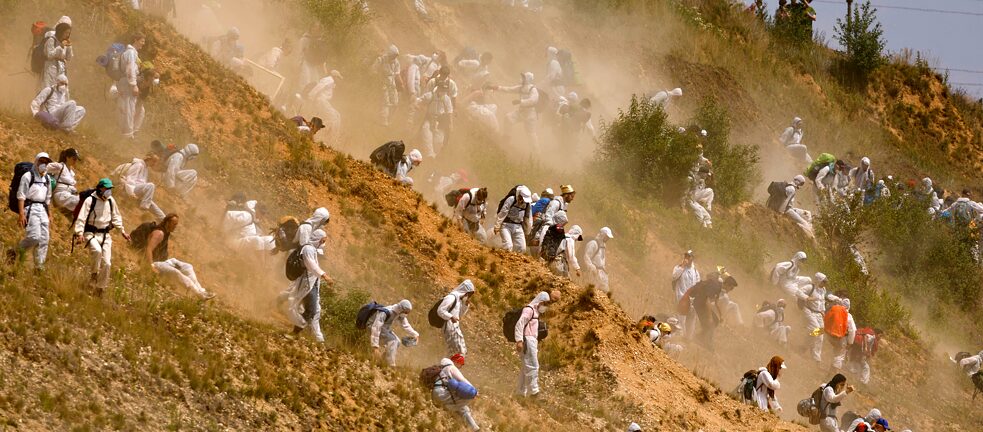 Members of the Ende Gelände alliance and demonstrators from Fridays for Future storm the Garzweiler open pit mine in 2019.
| Photo (detail): © picture alliance/Geisler-Fotopress/Christoph Hardt
Ende Gelände was also there in 2018 when coal opponents blocked the clearing of Hambach Forest the edge of the nearby Hambach open pit mine. Ende Gelände stormed the mine and occupied the coal excavators. They did not act alone, and the images of young people living for months in homemade tree houses to protect the trees from logging went around the world. In autumn 2018, the tree houses were cleared in large-scale police operation that has subsequently been classified as illegal. Still, protesters achieved their aims: together with local residents and demonstrators, the occupiers of trees and excavators brought the logging to a halt with human chains and large-scale protests until a judge’s ruling prevented the clearing of the forest. Activists have already taken up residence in trees around Lützerath and the Garzweiler open pit mine.
Members of the Ende Gelände alliance and demonstrators from Fridays for Future storm the Garzweiler open pit mine in 2019.
| Photo (detail): © picture alliance/Geisler-Fotopress/Christoph Hardt
Ende Gelände was also there in 2018 when coal opponents blocked the clearing of Hambach Forest the edge of the nearby Hambach open pit mine. Ende Gelände stormed the mine and occupied the coal excavators. They did not act alone, and the images of young people living for months in homemade tree houses to protect the trees from logging went around the world. In autumn 2018, the tree houses were cleared in large-scale police operation that has subsequently been classified as illegal. Still, protesters achieved their aims: together with local residents and demonstrators, the occupiers of trees and excavators brought the logging to a halt with human chains and large-scale protests until a judge’s ruling prevented the clearing of the forest. Activists have already taken up residence in trees around Lützerath and the Garzweiler open pit mine.
Local residents stand in complete solidarity with the anti-coal activists. They regularly bring food and equipment to the forest squatters both near the Hambach open pit mine and in the Garzweiler villages. In addition to supporters like the elderly lady who, after a guided tour, was so thrilled with the young people’s commitment that she returned in the evening with a few sheets of cake and the widow of an alpinist who lugged all his climbing equipment out into the forest, many occupiers also have “everyday godmothers” in the surrounding villages who wash their clothes and let them have a shower.
They are often right by their side during the protests too: Under the umbrella of the “Aller Dörfer bleiben!” (All Villages Must Stay) citizen’s initiative, farmers, employees, students and working people from the surrounding villages are refusing to give up their homes. “If the fight is won here, that will mean we’re safe too,” one woman from neighbouring Keyenberg said.
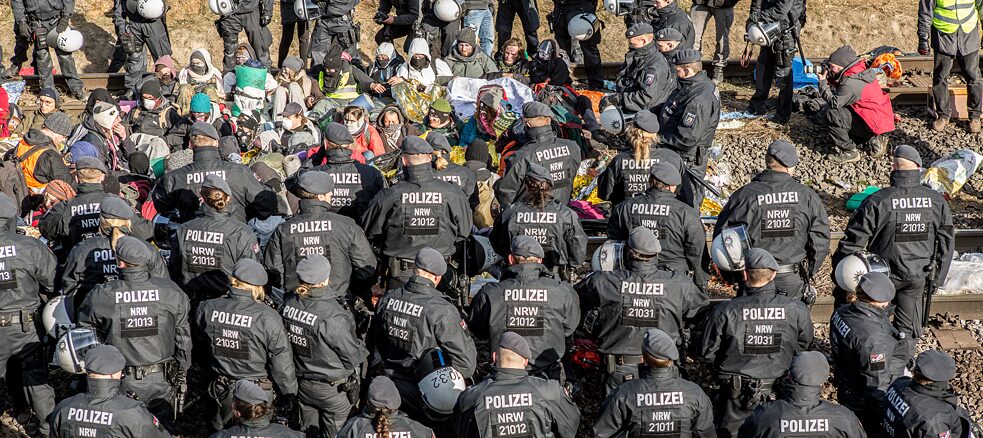 Civil disobedience also involves frequent confrontations with the police: "Ende Gelände" blockade at the Hambach open pit mine in October 2019.
| Photo (detail): © christianwillner.com/Ende Gelände (CC BY-NC 2.0)
Emilia Lange from Ende Gelände is happy the group enjoys “a lot of understanding from the people here for our more radical forms of resistance”. No one from the citizens’ initiative criticizes dredger occupations, even if they are illegal. Less prominent groups also occupy the excavators at Garzweiler from time to time, such as “Lebenslaute,” a 100-piece political orchestra that plays music in protest. At one concert called “Triole gegen Kohle” (Triplets against Coal), orchestra members stood under the conveyor belts belting out the Bach Suites and stopping work for hours.
Civil disobedience also involves frequent confrontations with the police: "Ende Gelände" blockade at the Hambach open pit mine in October 2019.
| Photo (detail): © christianwillner.com/Ende Gelände (CC BY-NC 2.0)
Emilia Lange from Ende Gelände is happy the group enjoys “a lot of understanding from the people here for our more radical forms of resistance”. No one from the citizens’ initiative criticizes dredger occupations, even if they are illegal. Less prominent groups also occupy the excavators at Garzweiler from time to time, such as “Lebenslaute,” a 100-piece political orchestra that plays music in protest. At one concert called “Triole gegen Kohle” (Triplets against Coal), orchestra members stood under the conveyor belts belting out the Bach Suites and stopping work for hours.
The Farmer Refusing to Give Up His Land
It is unclear whether the area can be saved, and excavator occupations, concerts and sit-in blockades are unlikely to be enough. But here in Lützerath, victory might still be possible, like in 2018 with Hambach Forest, where the Münster Higher Administrative Court declared the clearing of the forest unlawful immediately after protesters had been forced out. In September 2021, the Cologne Administrative Court even retroactively declared the crackdown by around 4,000 police officers to the tune of roughly 50 million euros illegal.
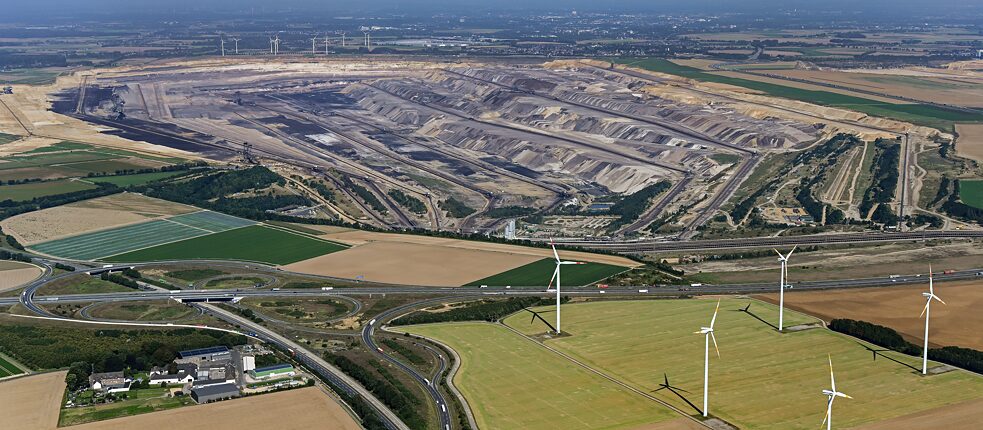 Coal and wind turbines: View of the Garzweiler opencast lignite mine.
| Photo (detail): © picture alliance/FotoMedienService/Ulrich Zillmann
In Lützerath, everyone is hoping the Münster Higher Administrative Court will issue an injunction against the expropriation of farmer Eckardt Heukamp. His 250-year-old farm stands right on the edge of the open pit mine. In Germany, seizing someone’s land is legal only if it serves to benefit the common good. So far, this justification has applied to coal mining, and several villages have been resettled for open pit mining in recent decades. Now though, opponents of coal argue that fossil energy production may have served the common good after the war, but today the common good means ending it as quickly as possible.
Coal and wind turbines: View of the Garzweiler opencast lignite mine.
| Photo (detail): © picture alliance/FotoMedienService/Ulrich Zillmann
In Lützerath, everyone is hoping the Münster Higher Administrative Court will issue an injunction against the expropriation of farmer Eckardt Heukamp. His 250-year-old farm stands right on the edge of the open pit mine. In Germany, seizing someone’s land is legal only if it serves to benefit the common good. So far, this justification has applied to coal mining, and several villages have been resettled for open pit mining in recent decades. Now though, opponents of coal argue that fossil energy production may have served the common good after the war, but today the common good means ending it as quickly as possible.
Many people have shown up to support farmer Heukamp. Some, like Seawatch captain Carola Rackete, are even camping out around his homestead and the adjacent meadows and forests. Others are showing their solidary through donations so Heukamp can shoulder the 90,000 euros he has spent so far on expert assessments and legal and court costs. “What is happening here is a crime against future generations,” one woman who came to protest says.
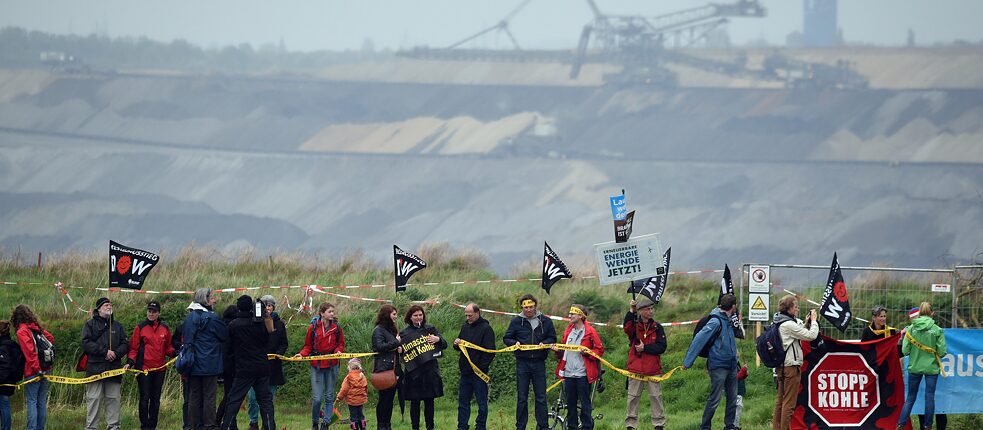 Resistance to opencast lignite mining has a long history: human chain against coal mining at the Garzweiler opencast mine in 2015.
| Photo (detail): © picture alliance/dpa/Henning Kaiser
Resistance to opencast lignite mining has a long history: human chain against coal mining at the Garzweiler opencast mine in 2015.
| Photo (detail): © picture alliance/dpa/Henning Kaiser
Day X
Lützerath is not the only place such “crimes against future generations” are taking place, nor is it the only place resistance is stirring either. From Bangladesh to England, from China to the USA, citizens are demonstrating against smog, activists are blocking coal transports and taking legal action. In South Africa, for example, fierce protests continue after an anti-coal activist was shot dead in her home there in the fall of 2020. In India, indigenous peoples embarked on a 300-kilometer protest march in October 2021. And in Australia, eight teenagers won a lawsuit against the environment minister, who is now obligated to intervene in potential further coal projects.
The political situation seems better in Germany, where the German government has pledged to put an end to coal – though not until 2038. Until then, the RWE energy company plans to continue operating its opencast mine and claim billions in subsidies. Over the decades, coal has destroyed the homes of thousands of people; monuments and churches have fallen victim to it, as have cultural landscapes, healthy soil, and intact natural environments. Politicians have repeatedly cited the future of employment as one reason the coal phase-out cannot be ramped up. In the 1960s, up to 100,000 people were still working in the Rhineland coalfields. Today, their number has dropped to around 9,000.
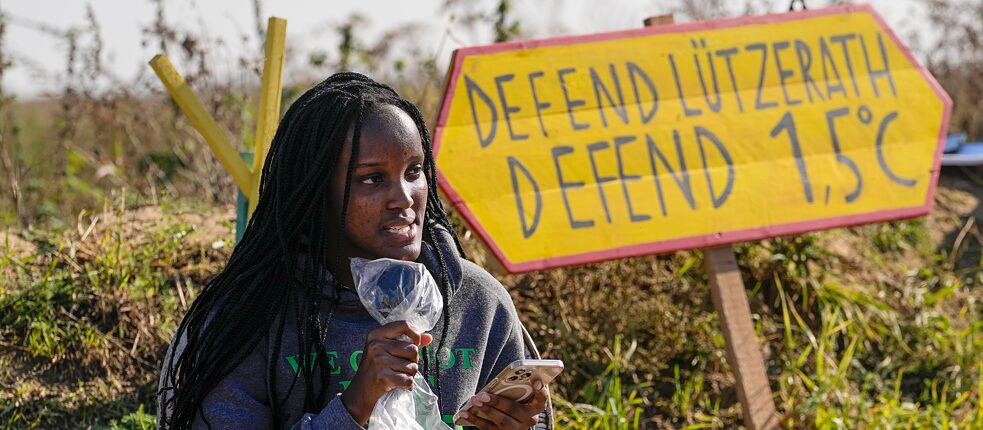 Lützerath has become a symbol for the fight for the 1.5 degree target for international climate activists too: After Greta Thunberg, Ugandan climate activist Vanessa Nakate also came to show her support for the protest in Lützerath in October 2021.
| Photo (detail): © picture alliance / Associated Press / Martin Meissner
Resistance is arduous, and successes are often short-lived: “While it’s true that Hambach Forest won’t be cleared,” Michael Zobel, a forest educator from Aachen, explains, clearing is still happening “around it, turning it into an island of sorts, which dries up the forest.”
Lützerath has become a symbol for the fight for the 1.5 degree target for international climate activists too: After Greta Thunberg, Ugandan climate activist Vanessa Nakate also came to show her support for the protest in Lützerath in October 2021.
| Photo (detail): © picture alliance / Associated Press / Martin Meissner
Resistance is arduous, and successes are often short-lived: “While it’s true that Hambach Forest won’t be cleared,” Michael Zobel, a forest educator from Aachen, explains, clearing is still happening “around it, turning it into an island of sorts, which dries up the forest.”
Meanwhile, the coal excavators, at 240 meters long and 100 meters tall the largest machines in the world, continue to dig like monstrous clockworks in the pits, which are up to 400 meters deep. Many wonder if they will continue at this pace until 2038. Before then, the day activists often talk about, Day X, may come. The day the demolition of the first empty houses in Lützerath is scheduled to start. Ende Gelände is not giving up: “We will all be there,” Emilia Lange says, marching in columns, by the hundreds, “under the protection of anonymity and our painter’s coveralls.”
How do we get away from fossil fuels?
About 90 percent of all greenhouse gas emissions are due to the burning of fossil fuels. Since industrialisation, the use of fossil energy has enabled continuous economic growth in the so-called Global North - which has thus mainly caused climate change. However, it is mainly countries from the so-called Global South that are affected by the consequences. In the meantime, in the case of 85 percent of the national markets, wind and sun are the least expensive forms of power generation when it comes to building new power plants. Yet, the global energy situation as a whole is still not very renewable. In 2019, according to the International Energy Agency, fossil fuels still account for four-fifths of primary energy consumption worldwide. There is a clear urgency for change. In our three reports on the topic of "Fossil Energy", the authors take a look at three approaches to the energy transition and ask the question of how we can change our ways of doing business.
0 Comments